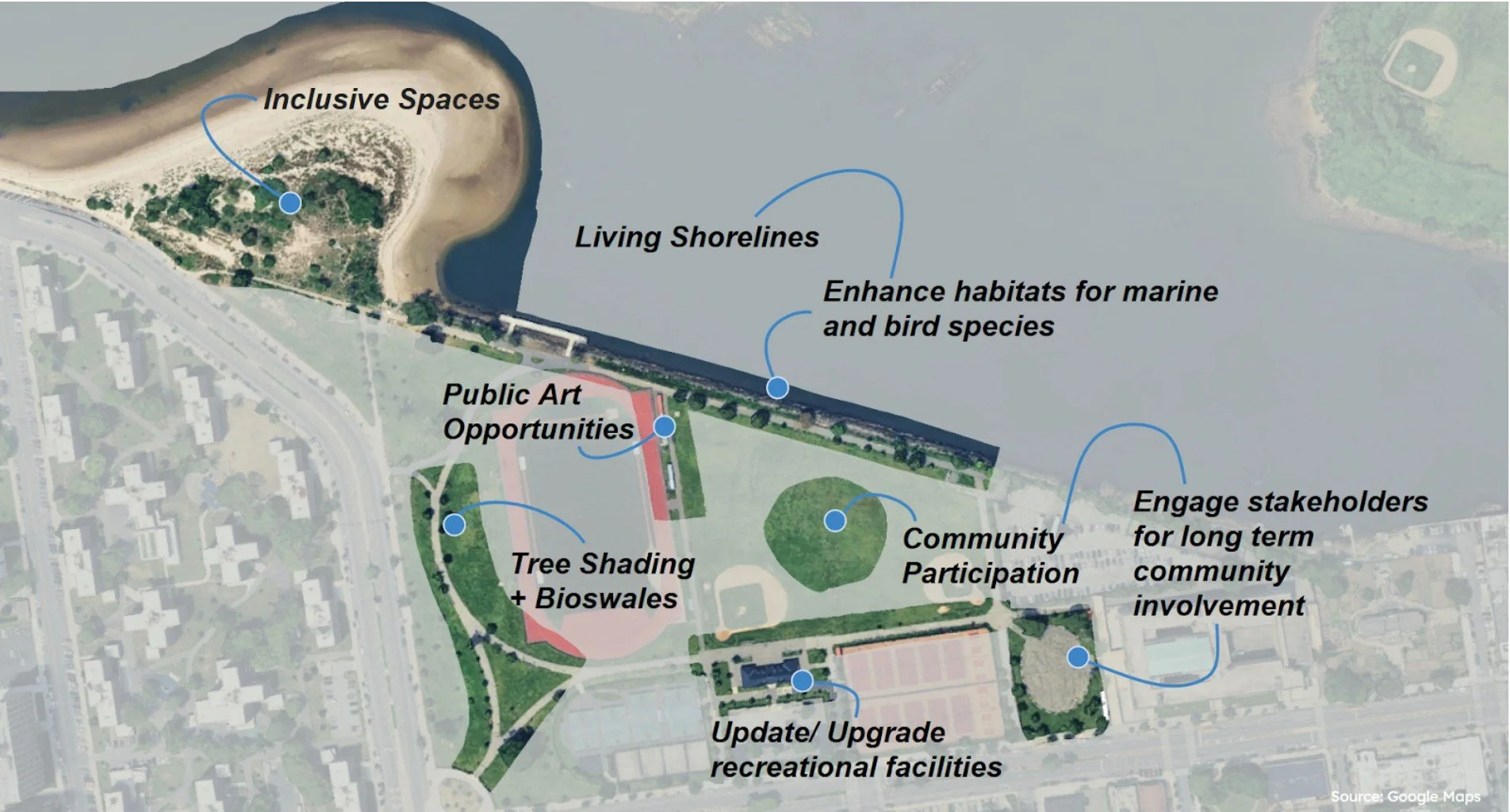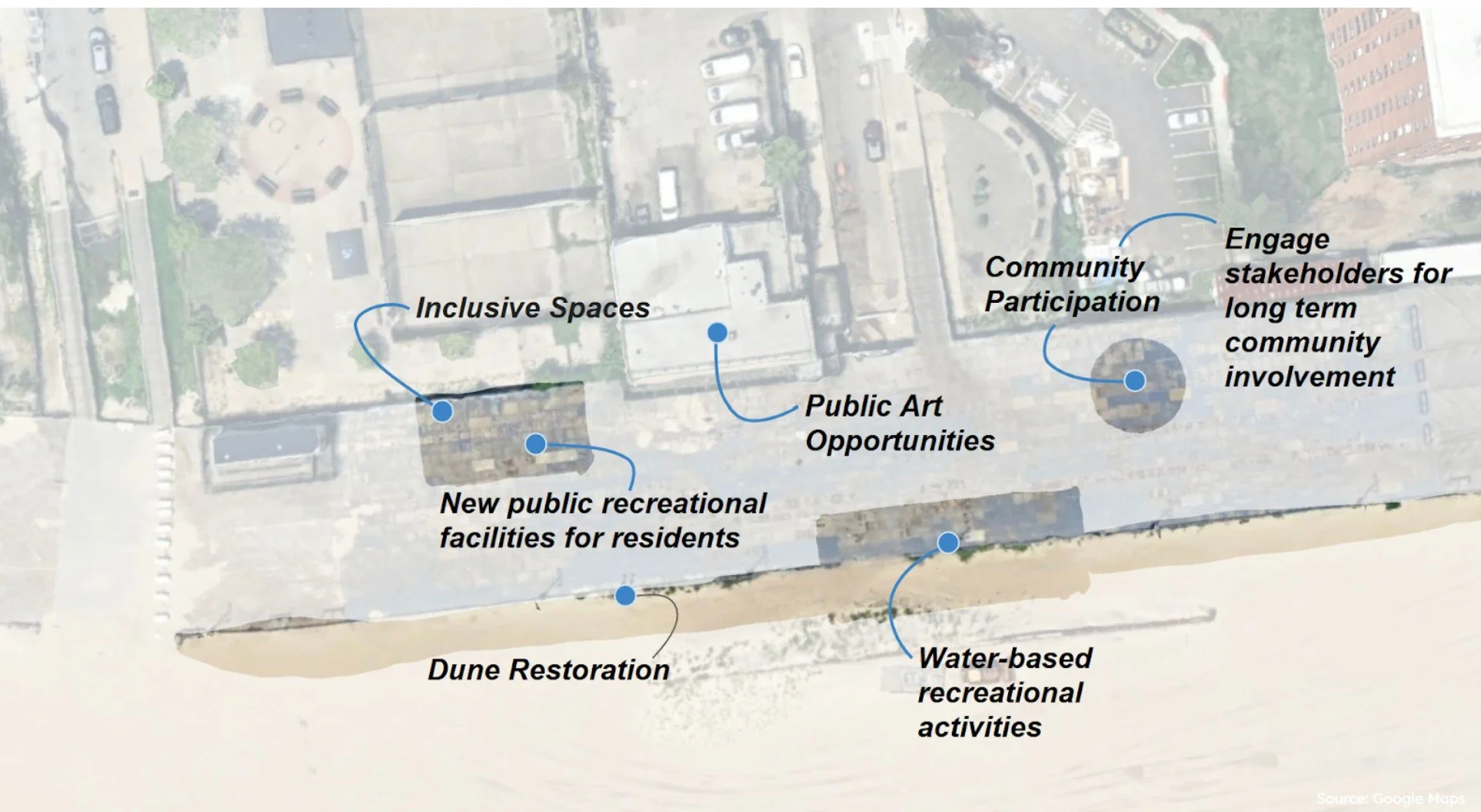Objective 2: Revitalize Kaiser Park and the Beloved Boardwalk through Green Infrastructure Planning and Development
The recommendations for improving green infrastructure and community connection at Kaiser Park and the Coney Island Boardwalk address two critical issues: the lack of sustainable infrastructure and limited opportunities for meaningful community engagement. These areas currently face environmental challenges such as stormwater management and urban heat island effects, exacerbated by inadequate greenery and green infrastructure. Simultaneously, these public spaces are underutilized as hubs for social and cultural activities. By adopting these recommendations, the community can transform these spaces into multifunctional environments that promote ecological health, resilience to climate change, and stronger social ties. These improvements could make Kaiser Park and the boardwalk models of sustainable urban development.
Diagrams: Proposed Improvements in Kaiser Park and the Coney Island Boardwalk (Source: Jasmin Malhotra)
Objectives
The objectives of these recommendations are to increase green space, implement sustainable stormwater management solutions, and strengthen the bonds within the community. By incorporating features such as rain gardens, bioswales, and permeable pavements, these spaces can mitigate flooding risks while beautifying the area. Additionally, creating spaces for recreation, cultural events, and educational programming fosters a sense of ownership and belonging among residents. Ultimately, the goal is to reduce environmental inequities and enhance the community's overall quality of life by providing accessible, functional, and aesthetically pleasing public spaces.
Who to Involve
To ensure the successful implementation of these recommendations, an inclusive and transparent governance structure is essential. A community committee of some kind should be formed, comprising residents, civic leaders, and representatives from local organizations. This committee would work closely with city agencies such as NYC DEP, as well as environmental nonprofits and academic institutions. By maintaining open communication and prioritizing the voices of local stakeholders, this governance model would ensure that the project aligns with the community’s needs and values.
Other stakeholders include:
NY Restoration Project: Gardens for the City
CI Beautification Project
Friends of Kaiser Park
Council member Justin Brannan
CI Boardwalk Reconstruction
GROW NYC
Green infrastructure, NY EDC
Steps to Take
Engaging the community is crucial for the success of this initiative. Residents, neighborhood associations, school groups, and local businesses all play vital roles in shaping and supporting the project. Youth groups and cultural organizations can further contribute by fostering long-term engagement and ensuring inclusivity in programming. By involving these stakeholders from the very beginning, the project can build trust and enthusiasm, ensuring its durability and relevance.
To mobilize the community, CINRC and its allies could host public workshops and pilot events, such as planting days or tours of potential green infrastructure sites. These activities could showcase the benefits of the project and also provide tangible opportunities for residents to participate. Social media campaigns and local newsletters can amplify these efforts, keeping the community informed and engaged throughout the process.
To make these recommendations successful, support from these actors will be essential. Financial resources from grants, sponsorships, or city funding will be necessary to cover the costs of design, implementation, and maintenance. Technical expertise from environmental engineers and urban planners will ensure that the project meets sustainability and resilience standards. Grassroots advocacy and community buy-in are equally important to foster long-term stewardship of these spaces.
The success of this initiative will depend on mobilizing a range of resources, including human, social, and financial capital. Local volunteers, students, and professionals can contribute time and expertise, while partnerships with schools, cultural organizations, and civic groups will provide invaluable social support. Financial resources can come from grants provided by the National Fish and Wildlife Foundation, sponsorships from local businesses, or even crowdfunding efforts. Together, these resources will create a foundation for transforming Kaiser Park and the Coney Island Boardwalk into thriving spaces that enhance both environmental and social well-being.


